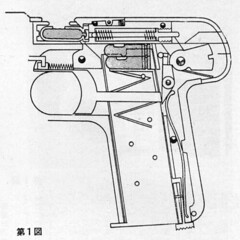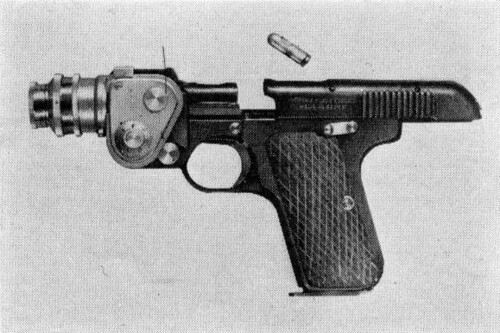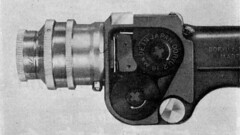Doryu 2-16
The Doryu 2-16 (ドリウ2-16型) is a pistol-shaped camera taking 16mm film, made from 1954 to 1956 by the Doryu company (certainly renamed Nihon 16-miri Shashin Kōgyō at some time).
Contents
Description
The device is shaped as an automatic pistol, with a handgrip and a trigger. The total weight is 582g, with 282g for the camera part alone (including the f/2.7 standard lens), and 300g for the rear part with the flash system (including five magnesium cartridges).[1] It is ideally distributed around the trigger,[2] giving good hand-held stability with focal lengths lower than 30mm.[3]

|
| From Shashin Kōgyō March 1955. This camera perhaps has serial no.10047. (Image rights) |
The rear part is very realistic, with a predominantly black finish. The handgrip contains a magazine, just as the bullet magazine of a real pistol, loaded with six magnesium cartridges.[4] The magazines are locked by a latch and are easily recognized by the name DORYU 2–16 engraved at the bottom. The cartridges are made of 0.1mm aluminium, rendered waterproof by 8/1000mm tinfoil and liquid vinyl.[5] Each cartridge contains 0.8 gram of magnesium powder.[6] It is ignited by a paper strip impregnated with gunpowder, as was used at the time in toy guns[7] — obviously a noisy process.[8]
 
|
| Flash cartridge and cartridge magazine. From Shashin Kōgyō March 1955. (Image rights) |
The trigger both trips the shutter and fires the magnesium cartridge. It is locked by a lever on the left, next to the handgrip.[9] Its movement is relayed to the flash cartridge by a sear, hammer and firing pin, exactly reproducing the mechanism of an actual firearm (see the drawings below).[10] When the cartridge is fired, burning magnesium powder is ejected through the aperture at the top, illuminating the scene up to a distance of 15m outdoors, and 20m indoors.[11] The temperature is extremely high, and there is a risk of severe burning if the cartridge is fired at your hand or face.[12] The flash duration is about 1/25 second, and varies with weather factors.[13] The shutter is not synchronized, and the flash system can be used the B setting only.[14]

|

|
| Trigger mechanism and firing sequence. From Shashin Kōgyō March 1955. (Image rights) | |
The breechblock is pulled to the rear to replace the flash cartridge. This movement ejects the used cartridge, extracts the next one from the magazine and puts the hammer back into firing position — an exact reproduction of the bullet loading sequence on a real pistol.[15] The breechblock's left-hand side is inscribed DORYU 2 FLASH CAMERA MADE IN JAPAN.

|
| Breechblock pulled to the rear, ejecting the flash cartridge. From Shashin Kōgyō March 1955. (Image rights) |
The camera part is placed at the front end, replacing the barrel of an actual pistol. It can be separated from the rear part, by fully unscrewing the round knob visible on the right, in front of the trigger, and by removing another screw, further to the rear. The breechblock can be pulled forward and removed for cleaning, after pushing the hammer down with a screwdriver, and the firing pin can be disassembled too.[16]
 
|
| Disassembly. From Shashin Kōgyō March 1955. (Image rights) |
The left-hand side plate is removable for film loading: it is unlocked by turning the latch by 180 degrees. The film door supports an exposure counter, graduated from 0 to 35, and a small fixed knob. The camera nominally takes thirty or thirty-two 10×10mm exposures on a 45cm film strip.[17] The film cassettes are similar in shape to those of the Mamiya 16,[18] but the film strip is rolled with the emulsion facing outwards.[19] It seems that the original cassettes are inscribed DORYU 2–16 MADE IN JAPAN (see the picture below).
There is a lever at the rear of the camera part, actuated by the right thumb, used to advance the film and cock the shutter. There is an accessory shoe on the same side, whose function is unclear: the shutter has no synch socket, and attaching an external viewfinder or rangefinder would be little practical in that position. The name DORYU 2–16 and serial number are repeated under the accessory shoe. The camera's built-in viewfinder consists of a single folding frame at the top. It does not indicate the whole field of view, and is only used to center the subject.[20]
 
|
| Front part of camera no.10002. From Shashin Kōgyō March 1955. (Image rights) |
The shutter is behind the lens mount, and normally gives B, 25, 50, 100 speeds.[21] These are selected by turning a ring, driven by a tab at the bottom. The lens is interchangeable, and the camera takes C-mount cine lenses (see below for the lenses specific to the Doryu).
History
Early development
The Doryu pistol-shaped cameras were developed for police and surveillance tasks, mainly to catch photographic proof of criminal behaviour in the act.[22] (Despite what is said in some sources, none of these cameras was designed for shooting training.)[23] The police forces also felt the need for a camera specially designed to photograph protesters during demonstrations, notably after the "bloody May Day incident" (血のメーデー事件), a clash between Tokyo protesters and policemen on May Day 1952.[24] The specifications asked for a pistol-shaped camera, easy to use with a single hand (see Mamiya Pistol).[25]
The first Doryu camera was the Doryu 1, taking 9.5mm film, which was completed in 1952 and was rapidly abandoned for durability problems, and because of the low availability of the film stock.[26] The company immediately began to develop its successor the Doryu 2-16, taking 16mm film, which was completed in July 1954.[27] By the time, the police forces had already selected the Mamiya Pistol, made to the same specifications[25] and supplied just in time for May Day 1954, and they rejected the Doryu. The camera was nonetheless produced for the civilian market, albeit it was hardly meeting any need. The camera internals were heavily modified before entering actual production: the number of parts (excluding the lens and shutter) was cut from 232 on the first prototype to 93 on the production version.[28] This move improved the durability and reliability and contributed to cutting costs.[29]
Contemporary documents
The Doryu is mentioned in Japanese magazines as early as July 1954.[30] The March 1955 issue of Shashin Kōgyō contains an article about the camera written by Andō Katsuyasu, an employee of the Doryu company.[31] It shows pictures of at least two early examples, with serial numbers 10002 and perhaps 10047 (these are reproduced in this page).
The camera was advertised in Sankei Camera from July 1955.[32] The earliest advertisement, placed by Doryu Camera, says that the "Doryu 2-16 Flash Camera" would be "available soon", with a Doryu 17/2.5 lens.[33] The September 1955 advertisement mentions the maker Doryu Camera and the company Komamura Shōkai, distributor for the Kansai area (Western Japan).[34] It gives a choice of three Dorymar lenses: 15/2.2, 17/2.5 and 17/2.7 (see below). The price is not indicated in either document, but one recent source reports ¥12,500.[35] Later advertisements, placed until February 1956, reportedly show the company name Nihon 16-miri Shashin Kōgyō, certainly a successor to Doryu Camera.[36]
Overall quality
It is said that the camera part was incompetently made. One author, who seems to have actually tried the camera, says that "the shutter is poor, the film flatness is not good, there are light leaks and the lens quality is bad".[37] (To be fair, the film flatness problems were perhaps caused by an improper use of Mamiya cassettes loaded with the emulsion inwards, giving a more contorted film path.)
These faults certainly explain the failure to meet the police specifications. The only advantage of the Doryu was arguably its built-in flash system, allowing to take pictures at night. But the absence of synchronization, making flash exposures possible in B setting only, detracts much from its usability, and the bursting magnesium cartridges were certainly very dangerous for the user, making the camera a complete failure.
Variations on actual examples

|
| From Shashin Kōgyō March 1955. (Image rights) |
The serial numbers observed on surviving examples run from 10017 to 10574, for an estimated total production of about 600 units.
Example no.10002 pictured in Andō's article has the word PATENT engraved under the serial number, absent on the other known cameras. Early examples (observed from 10017 to 10133) have a non slip brown covering on both sides of the handgrip, and usually come with a nickel-finished cartridge magazine. Late examples (observed from 10322 to 10490) have chrome plates on the handgrip, with an X-shaped rib and a small DORYU logo engraved. They usually come with a chrome-finished cartridge magazine.
Most cameras have the regular speed range (B, 25–100), but at least one camera reportedly has B, 50, 100, 200 engravings, perhaps without any actual internal change.[38]
The Doryu 2-16 is sometimes found in its presentation box, with a small plastic box containing the flash cartridges.[39] Two types of leather cases are known: one is a closed zipped case, embossed with the DORYU logo,[40] and the other is a leather holster, probably made specifically for the camera.[41]
Lenses
The May 1955 article in Shashin Kōgyō mentions two lenses specifically made for the Doryu 2-16: a Polymar 17/2.7 standard lens focusing to 25cm and a 15/2.2 "wide-angle" lens focusing to 15cm.[42] The 15mm lens gives a very limited wide-angle effect, deemed useful to catch the subject with little aiming effort.[43]
The 1955 advertisements observed so far mention a total of three lenses: 15/2.2, 17/2.5 and 17/2.7, named "Doryu" (ドリュー) or "Dorymar" (ドリマー) — these names might be inaccurate.[44]
The surviving examples are usually found with a Hokutar 17/2.7, Dorymar 17/2.5 or Dorymar Wide Angle 15/2.2.[45] The lens number patterns are not fully understood: it seems that the Hokutar is numbered in the 1xxx range, the Dorymar 17/2.5 in the D25xxx range, and the Dorymar Wide Angle 15/2.2 in the 522xxx range. At least one camera has been sold with a Dol Fixed Iris 30/5.6 lens, whose details are unknown.[46]
Notes
- ↑ Andō, p.215: 総重量五八二グラムで各部分の重量はカメラ部(F二・七レンズを含み)二八二グラム、発光装置部分(弾倉、閃光弾5発を含み)三〇〇グラムで[...].
- ↑ Andō, p.215: 引金上部が全重量の中心となっております.
- ↑ Andō, p.215: 撮影時の安定度は30ミリ以上の交換レンズを取付けぬ限り、カメラブレはほとんどありません.
- ↑ Six cartridges: Andō, p.216 (弾倉には六発迄閃光弾が入ります) ; Sugiyama, item 5029; Kokusan kamera no rekishi, p.356.
- ↑ Andō, p.216: 〇・一ミリのアルミキャップと、8/1000ミリの錫箔及びビニール液で完全に防水してあります.
- ↑ Andō, p.216: 弾体内に〇・八グラムのマグネシウム粉[...]が入り[...].
- ↑ Andō, p.216: 後部に発光剤(玩具用紙火薬)が入り[...].
- ↑ Andō, p.216, says that the noise produced by the Doryu flash system varies with the weather, and is much lower than that of an actual pistol.
- ↑ Andō, p.216, mentions a lock mechanism.
- ↑ The trigger mechanism is described in Andō, p.216.
- ↑ Andō, p.216: 夜間撮影距離は暗黒の室外で十五メートルまで、暗黒室内で二〇メートルまで出来ます.
- ↑ Andō, p.216, mentions temperatures as high as 4,000°F, and this is confirmed by Wikipedia's page on magnesium.
- ↑ Andō, p.216.
- ↑ Andō, p.216, says that the characteristics of magnesium combustion makes it impossible to synchronize with speeds higher than 1/10. This may be true for the Doryu cartridges, but flash bulbs filled with magnesium have been successfully used with much higher speeds.
- ↑ The loading mechanism is described in Andō, p.216.
- ↑ The sequence is described in Andō, p.216.
- ↑ Mamiya cassettes: Nakajima, p.144 of Kurashikku Kamera Senka no.35. Thirty exposures: advertisement in Sankei Camera September 1955, reproduced in Kokusan kamera no rekishi, p.153. Thirty-two exposures on a 45cm film strip: Andō, p.216 (長さ45センチフィルムで32枚まで撮影出来ます). 10×10mm format: Andō, p.215 (10×10ミリの画面); McKeown, p.250; Sugiyama, item 5029; Kokusan kamera no rekishi, p.356.
- ↑ Nakajima, p.144 of Kurashikku Kamera Senka no.35.
- ↑ Andō, p.216: 感光画が普通と逆になりますから、フィルムをマガジンに詰める時は裏返しに巻きます.
- ↑ Andō, p.216: ファインダーは秘密撮影及び閃光弾の関係上、中心焦準式で窓枠と画面は一致いたしません.
- ↑ B, 25, 50, 100: instruction sheet reproduced in this page by Auction Team Breker, and Andō, pp.215–6 (シャターは[...]B・1/25・1/50・1/100の四段階です).
- ↑ Andō, p.214: 防犯警備用を目的として設計されている and 犯人や現状の証拠撮影.
- ↑ See for example Pritchard, p.146, who mentions "use in police training".
- ↑ See the Japanese Wikipedia page on the incident.
- ↑ 25.0 25.1 Nakajima, p.144 of Kurashikku Kamera Senka no.35, says that the Doryu 2-16 and Mamiya Pistol were answering the same specifications.
- ↑ Andō, p.214: この[ドリウ1-9.5型]カメラは耐久力とフィルムの入手困難のため、発売するに至らず[...].
- ↑ Andō, p.214: 同年新たにドリウ2-16型を設計、昭和29年7月完成しました.
- ↑ Andō, p.215: 2型の試作1号では、レンズ、シャッターを除き二三二点の部品を現在は僅か九三点まで切り詰めています.
- ↑ Andō, p.215: これは相当の衝撃に耐えるためには部品を少くし、それだけ故障箇所を無くするためでコストの切り下げはそれに従ったのであります.
- ↑ Kokusan kamera no rekishi, p.356.
- ↑ Andō, pp.214–7.
- ↑ Kokusan kamera no rekishi, p.356.
- ↑ Advertisement reproduced in Kokusan kamera no rekishi, p.153.
- ↑ Advertisement reproduced in Kokusan kamera no rekishi, p.153.
- ↑ Price: this page at Sepia World (archived).
- ↑ Kokusan kamera no rekishi, p.356.
- ↑ Nakajima, p.144 of Kurashikku Kamera Senka no.35, who seems to have actually taken pictures with the camera.
- ↑ Nakajima, p.144 of Kurashikku Kamera Senka no.35, mentioning the camera owned by the Pentax Gallery.
- ↑ The set is pictured in Pritchard, p.147.
- ↑ Camera sold as lot no.643 of Westlicht Photographica Auction no.3 (May 24, 2003); see the links below.
- ↑ Camera sold as lot no.722 of Westlicht Photographica Auction no.9 (May 20, 2006).
- ↑ Andō, p.215: レンズは[...]POLYMAR十七ミリf二・七を標準に十五ミリf二・二広角レンズを併用しております and 最短撮影距離が各々二五センチ及一五センチまで.
- ↑ Andō, p.215: この種の広角レンズは、秘密撮影や狙写に被写体を欠かないこと[...]などの理由により使用いたしました.
- ↑ Advertisements in Sankei Camera July and September 1955, reproduced in Kokusan kamera no rekishi, p.153.
- ↑ The lens name "Dormar" given in Pritchard, p.147, is a mistake.
- ↑ Past auction record by Christies.
Bibliography
- Andō Katsuyasu (安藤勝康). "Doriu 2–16 gata kamera" (ドリウ2–16型カメラ, Doryu 2-16 camera). In Shashin Kōgyō no.33 (March 1955). Pp.214–7.
- Asahi Camera (アサヒカメラ) editorial staff. Shōwa 10–40nen kōkoku ni miru kokusan kamera no rekishi (昭和10–40年広告にみる国産カメラの歴史, Japanese camera history as seen in advertisements, 1935–1965). Tokyo: Asahi Shinbunsha, 1994. ISBN 4-02-330312-7. Item 633 (see also the pictures on pp.19 and 438.)
- Awano Mikio (粟野幹男). "Tokushū: Mame kamera ni tsuite" (特集・豆カメラについて, Special: On subminiature cameras). In Camera Collectors' News no.31 (January 1980). Nishinomiya: Camera Collectors News-sha. (Pictures on the front and back cover.)
- McKeown, James M. and Joan C. McKeown's Price Guide to Antique and Classic Cameras, 12th Edition, 2005-2006. USA, Centennial Photo Service, 2004. ISBN 0-931838-40-1 (hardcover). ISBN 0-931838-41-X (softcover). P.250.
- Nakajima Akitoshi (中島章年). "Kenjū magai no yunīku na sutairu — Doryū 2-16" (拳銃まがいのユニークなスタイル・ドリュー2-16, The Doryu 2-16, with a unique pistol-like style). Kamera Rebyū: Kurashikku Kamera Senka (カメラレビュー クラシックカメラ専科) / Camera Review: All about Historical Cameras no.35, November 1995. Nihon no kamera 50nen (日本のカメラ50年, special issue on 50 years of Japanese cameras). P.144.
- Pritchard, Michael and St. Denny, Douglas. Spy Cameras — A century of detective and subminiature cameras. London: Classic Collection Publications, 1993. ISBN 1-874485-00-3. Pp.146–7.
- Sugiyama, Kōichi (杉山浩一); Naoi, Hiroaki (直井浩明); Bullock, John R. The Collector's Guide to Japanese Cameras. 国産カメラ図鑑 (Kokusan kamera zukan). Tokyo: Asahi Sonorama, 1985. ISBN 4-257-03187-5. Item 5029.
Links
In English:
- Past sales by Westlicht Photographica Auction (now Leitz Photographica Auction):
- Doryu 2-16 serial no. 10382, lot no.643 of the second/third auction (May 24, 2003)
- Doryu 2-16 serial no. 10133, lot no.722 of the ninth auction (May 20, 2006)
- Doryu 2-16 serial no. 10357 (lot 597), and flash cartridge magazine (lot 598), sold at the thirteenth auction (June 7, 2008)
- Doryu 2-16 serial no. 10574, lot no.499 of the seventeenth auction (May 29, 2010)
- Doryu 2-16, lot no.278 of January 16, 2001 auction by Christies
- Doryu 2-16 among the highlights of the April 26, 2008 sale by Auction Team Breker
- Doryu 2-16 serial no. 10541, with Dol 30 mm f/5.6 lens, in presentation box with flash cartridge case, offered for sale at the auction Important and Rare Cameras by Bonhams Hong Kong on 3 December 2015.
- Doryu 2-16 among 16mm film cameras at Subclub.org
In French:
- Doryu 2-16 among gun-shaped cameras at Procrastin (the picture is that of Red Book Nikkor)
In Japanese:
- Doryu 2-16 in the March 2005 Nikon Kenkyukai, at Red Book Nikkor
- Doryu 2-16 among gun-shaped cameras at the JCII Camera Museum (individual page archived December 2018)
